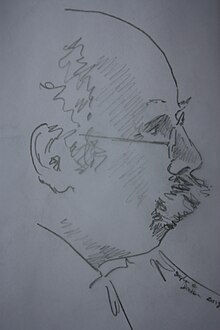Napier Shaw
Sir Napier Shaw | |
|---|---|
 | |
| Born | 4 March 1854 |
| Died | 23 March 1945 (aged 91) |
| Nationality | British |
| Known for | Tephigram |
| Awards | Royal Medal (1923) Buys Ballot Medal (1923) |
| Scientific career | |
| Fields | Meteorologist |
Sir William Napier Shaw FRS[1] (4 March 1854 – 23 March 1945) was a British meteorologist.[2] He introduced the tephigram, a diagram for evaluating convective instability in the atmosphere.[3] He also served as president of the International Meteorological Committee and Royal Meteorological Society.
Biography[edit]
Shaw was born at 84 Vyse Street in Birmingham the son of Charles Thomas Shaw, a goldsmith and jeweller, and his wife, Kezia Lauden. He was educated at King Edward's School, Birmingham.[4]
He studied at Cambridge University graduating MA in 1876, then at the University of Berlin in Berlin.
Returning to Britain he began as a Demonstrator in Physics at the Cavendish Laboratory linked to Cambridge University in 1879. In 1887 he began lecturing in Experimental Physics. In 1898 he became Assistant Director of the Cavendish Laboratory.
In 1891, he was elected a Fellow of the Royal Society.[1][5][6]
In 1900 he became Secretary of the Meteorological Council. From 1905 to 1907 he was Director of the Meteorological Office. In 1907 he became the first Professor of Meteorology at Imperial College, London.[7]
In 1911 he served as President of the International Meteorological Committee, forerunner of the World Meteorological Organization.[8] In 1915, he developed the tephigram. He was knighted by King George V later that year.
He was President of the Royal Meteorological Society 1918/19. In 1933 he was elected an honorary Fellow of the Royal Society of Edinburgh.[9]
Shaw also studied air pollution, and was the first to study and discuss smog and look at its health problems. In 1925, he co-authored the book The Smoke Problem of Great Cities with John Switzer Owens.[10]
Shaw retired in 1924 aged 70 and died in London aged 91.
Family[edit]
In 1885 he married Sarah Jane Dugdale Harland (d.1923). They had no children.[11]
Publications[edit]
- Practical Physics (1893)
- Forecasting Weather (1911)
- Articles on "Dew", "Fog","Squall" and "Sunshine" in the Encyclopaedia Britannica (1911)
- The Smoke Problem of Great Cities (1925)
- Manual of Meteorology (1926) plus several later editions
Honours and awards[edit]
- 1910: He was awarded the Symons Gold Medal of the Royal Meteorological Society
- 1923: He was awarded a Royal Medal by the Royal Society.
- 1924: He was an Invited Speaker of the ICM in Toronto.[12]
References[edit]
- ^ a b Gold, E. (1945). "William Napier Shaw. 1854-1945". Obituary Notices of Fellows of the Royal Society. 5 (14): 203. doi:10.1098/rsbm.1945.0013. S2CID 162320211.
- ^ "Obituary Notice: Shaw, William Napier". Monthly Notices of the Royal Astronomical Society. 106 (1): 35–37. 1946. Bibcode:1946MNRAS.106...35.. doi:10.1093/mnras/106.1.35.
- ^ Burton, J. (2004). "William Napier Shaw – Father of modern meteorology". Weather. 59 (11): 307. Bibcode:2004Wthr...59..307B. doi:10.1256/wea.45.04.
- ^ Biographical Index of Former Fellows of the Royal Society of Edinburgh 1783–2002 (PDF). The Royal Society of Edinburgh. July 2006. ISBN 0-902-198-84-X. Archived from the original (PDF) on 4 March 2016. Retrieved 17 June 2018.
- ^ Addison, Henry Robert; Oakes, Charles Henry; Lawson, William John; Sladen, Douglas Brooke Wheelton (1907). "SHAW, William Napier". Who's Who. Vol. 59. pp. 1591–1592.
- ^ Gilman, D. C.; Peck, H. T.; Colby, F. M., eds. (1905). . New International Encyclopedia (1st ed.). New York: Dodd, Mead.
- ^ Biographical Index of Former Fellows of the Royal Society of Edinburgh 1783–2002 (PDF). The Royal Society of Edinburgh. July 2006. ISBN 0-902-198-84-X. Archived from the original (PDF) on 4 March 2016. Retrieved 17 June 2018.
- ^ "William Napier Shaw, F.R.S. - Scientific American". Scientific American.
- ^ Biographical Index of Former Fellows of the Royal Society of Edinburgh 1783–2002 (PDF). The Royal Society of Edinburgh. July 2006. ISBN 0-902-198-84-X. Archived from the original (PDF) on 4 March 2016. Retrieved 17 June 2018.
- ^ Shaw, Napier; Owens, John Switzer (1925). The Smoke Problem of Great Cities. London: Constable & Company. Retrieved 17 January 2022.
- ^ Biographical Index of Former Fellows of the Royal Society of Edinburgh 1783–2002 (PDF). The Royal Society of Edinburgh. July 2006. ISBN 0-902-198-84-X. Archived from the original (PDF) on 4 March 2016. Retrieved 17 June 2018.
- ^ Shaw, Napier. "The convective energy of saturated air in a natural environment". In: Proceedings of the International Congress of Mathematicians in Toronto, August 11–16. 1924. Vol. 2. pp. 305–313.
External links[edit]
